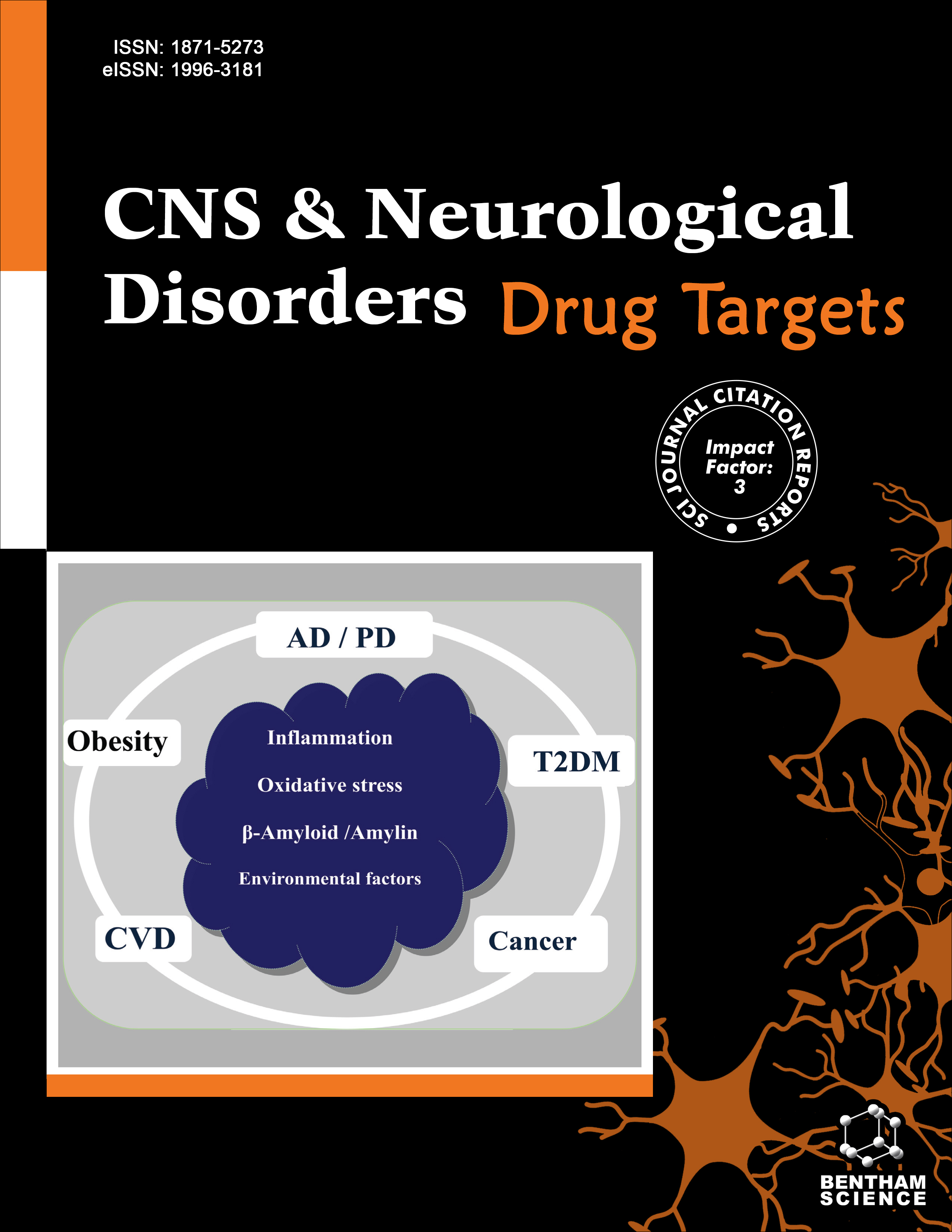- Home
- A-Z Publications
- CNS & Neurological Disorders - Drug Targets (Formerly Current Drug Targets - CNS & Neurological Disorders)
- Previous Issues
- Volume 21, Issue 1, 2022
CNS & Neurological Disorders - Drug Targets (Formerly Current Drug Targets - CNS & Neurological Disorders) - Volume 21, Issue 1, 2022
Volume 21, Issue 1, 2022
-
-
The Endocannabinoid System and Alcohol Dependence: Will Cannabinoid Receptor 2 Agonism be More Fruitful than Cannabinoid Receptor 1 Antagonism?
More LessAuthors: Aboagyewaah Oppong-Damoah, Brenda M. Gannon and Kevin Sean MurnaneAlcohol-use disorder (AUD) remains a major public health concern. In recent years, there has been a heightened interest in components of the endocannabinoid system for the treatment of AUD. Cannabinoid type 1 (CB1) receptors have been shown to modulate the rewarding effects of alcohol, reduce the abuse-related effects of alcohol, improve cognition, exhibit anti-inflammatory, and neuroprotective effects, which ar Read More
-
-
-
Direct Modulation of the Gut Microbiota as a Therapeutic Approach for Alzheimer’s Disease
More LessAuthors: Yi Wang and Gary A. DykesAlzheimer’s disease is a neurodegenerative disease characterized by a progressive decline in memory and cognitive functions. It is a multifactorial disease involving a wide range of pathological factors that are not fully understood. As supported by a growing amount of evidence in recent years, gut microbiota plays an important role in the pathogenesis of Alzheimer’s disease through the brain-gut-microbiota axis. This suggests t Read More
-
-
-
Medicinal Herbs and Nutritional Supplements for Dementia Therapy: Potential Targets and Clinical Evidence
More LessSpices and herbs have been used for medicinal purposes for centuries. Also, in the last decades, the use of different nutritional supplements has been implemented to treat all kinds of diseases, including those that present an alteration in cognitive functioning. Dementia is a clinical syndrome in which a person's mental and cognitive capacities gradually decline. As the disease progresses, the person’s autonomy diminishes. As t Read More
-
-
-
Role of Calcium Homeostasis in Ischemic Stroke: A Review
More LessAuthors: Abhilash Ludhiadch, Rashmi Sharma, Aishwarya Muriki and Anjana MunshiStroke is the second most common cause of death worldwide. It occurs due to the insufficient supply of oxygen-rich blood to the brain. It is a complex disease with multiple associated risk factors, including smoking, alcoholism, age, sex, ethnicity, etc. Calcium ions are known to play a vital role in cell death pathways, which is a ubiquitous intracellular messenger during and immediately after an ischemic period. Disruption in Read More
-
-
-
Neural Basis of Dental Pulp Stem Cells and its Potential Application in Parkinson’s Disease
More LessAuthors: Yogita Sharma, K Shobha, Mata Sundeep, Venkata B. Pinnelli, Shagufta Parveen and Anandh DhanushkodiParkinson’s Disease (PD) is the second most common neurodegenerative disease after Alzheimer’s disease. Though significant insights into the molecular-biochemical-cellular-behavioral basis of PD have been understood, there is no appreciable treatment available till date. Current therapies provide symptomatic relief without any influence on the progression of the disease. Stem cell therapy has been vigorously explored to tr Read More
-
-
-
The Protective Effects of Pioglitazone Against Cognitive Impairment Caused by L-methionine Administration in a Rat Model
More LessPurpose: Accumulating evidence indicates that elevated levels of methionine are associated with cognitive decline, including loss of memory. The exact mechanisms behind this observation are not completely understood but could be related to an increase in oxidative stress markers in hippocampal tissues. The above increase in oxidative stress could be directly caused by an increase in the blood levels of methionine (hy Read More
-
-
-
Conifer Essential Oils Reversed Amyloid Beta1-42 Action by Modulating BDNF and ARC Expression in The Rat Hippocampus
More LessBackground: The conifer species Pinus halepensis (Pinaceae) and Tetraclinis articulata (Cupressaceae) are widely used in traditional medicine due to their beneficial health properties. Objective: This study aimed to investigate the mechanisms by which P. halepensis and T. articulata essential oils (1% and 3%) could exhibit neuroprotective effects in an Alzheimer's disease (AD) rat model, induced by intracerebroventricular (i.c.v.) a Read More
-
-
-
Dioclea Altissima Seed Lectin (DAL) Prevents Anxiety-like Behavioral Responses in Adult Zebrafish (Danio Rerio): Involvement of GABAergic and 5-HT Systems
More LessBackground: Plant lectins have shown promising neuropharmacological activities in animal models. Objective: This study evaluated the effect of Dioclea altissima seed lectin (DAL) on adult zebrafish behavior. Method: Zebrafish (n=6/group) were treated (i.p.; 20 μL) with DAL (0.025; 0.05 or 0.1 mg/mL), vehicle or diazepam (DZP) and submitted to several tests (open field, light/dark preference or novel tank). Flumazenil, pizoti Read More
-
Volumes & issues
-
Volume 24 (2025)
-
Volume 23 (2024)
-
Volume 22 (2023)
-
Volume 21 (2022)
-
Volume 20 (2021)
-
Volume 19 (2020)
-
Volume 18 (2019)
-
Volume 17 (2018)
-
Volume 16 (2017)
-
Volume 15 (2016)
-
Volume 14 (2015)
-
Volume 13 (2014)
-
Volume 12 (2013)
-
Volume 11 (2012)
-
Volume 10 (2011)
-
Volume 9 (2010)
-
Volume 8 (2009)
-
Volume 7 (2008)
-
Volume 6 (2007)
-
Volume 5 (2006)
Most Read This Month
Article
content/journals/cnsnddt
Journal
10
5
false
en

Most Cited Most Cited RSS feed
-
-
A Retrospective, Multi-Center Cohort Study Evaluating the Severity- Related Effects of Cerebrolysin Treatment on Clinical Outcomes in Traumatic Brain Injury
Authors: Dafin F. Muresanu, Alexandru V. Ciurea, Radu M. Gorgan, Eva Gheorghita, Stefan I. Florian, Horatiu Stan, Alin Blaga, Nicolai Ianovici, Stefan M. Iencean, Dana Turliuc, Horia B. Davidescu, Cornel Mihalache, Felix M. Brehar, Anca . S. Mihaescu, Dinu C. Mardare, Aurelian Anghelescu, Carmen Chiparus, Magdalena Lapadat, Viorel Pruna, Dumitru Mohan, Constantin Costea, Daniel Costea, Claudiu Palade, Narcisa Bucur, Jesus Figueroa and Anton Alvarez
-
-
-
- More Less

